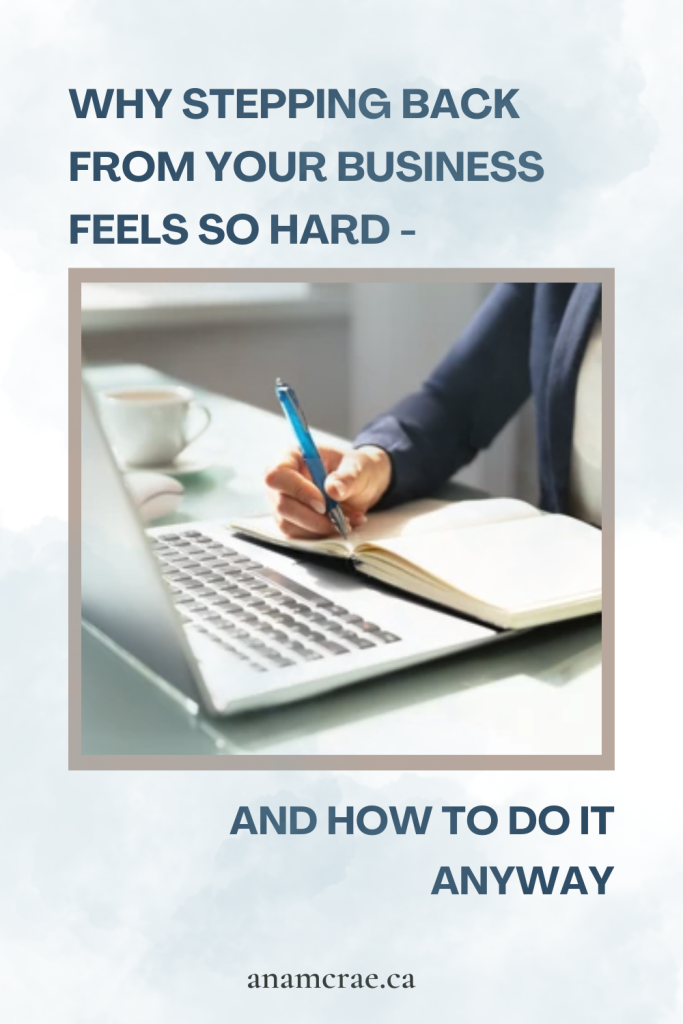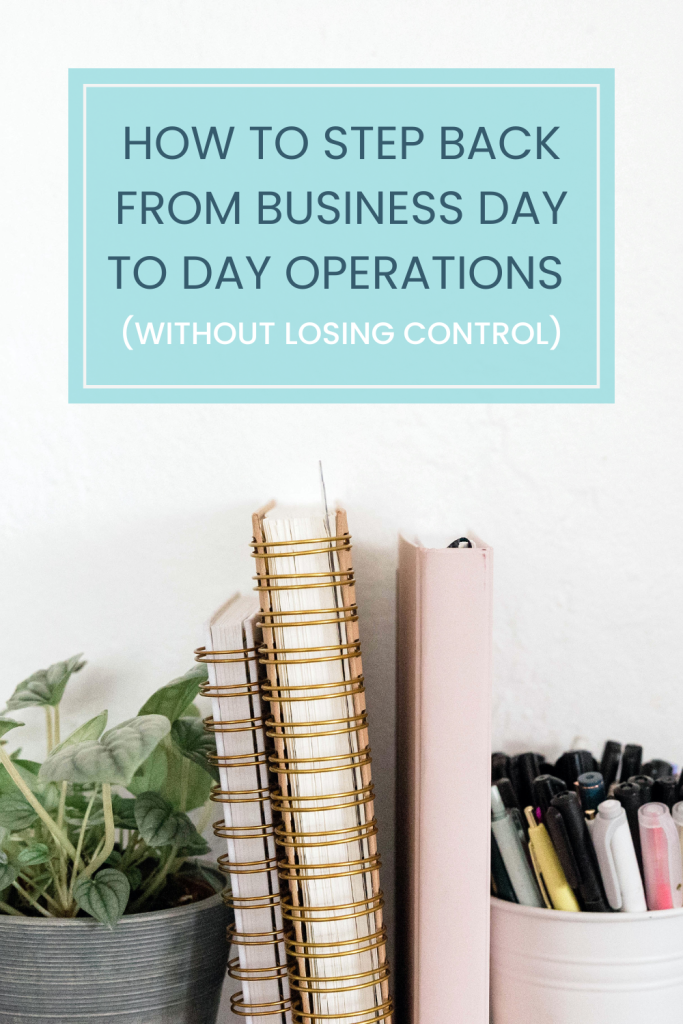How to Step Back from Business Day To Day Operations (Without Losing Control)12 min read
If you’re wondering how to step back from business day to day operations without losing control or having it all fall apart, this article will outline the exact mindset shifts and practical strategies to successfully transition from service provider to CEO.
Most of us started businesses because we wanted more freedom — financial freedom, time freedom, and the freedom to choose what work to do. We were all told that starting a business is the hardest part but no one ever talks about what happens afterwards – when you have a thriving multi-six figure business with its own set of challenges.
Your business is eating up all your time, energy, and headspace. You want to step out of the day to day but you aren’t quite sure how to keep it running smoothly without you. And even though logically you know that’s the next step to scaling it, emotionally it feels super uncomfortable to be working less…
I see this all the time with high-achieving entrepreneurs who are ready to scale. They’ll say, “I want to step back from the day to day business operations,” or “I want to work fewer hours and actually have time to walk my dog.”
But when we dig into what’s getting in the way, it’s not just structure or systems.
It’s fear.
Fear that the team will think they’re lazy.
Fear that stepping back means they’re less valuable.
Fear that they’ll lose control, relevance, or purpose.
And if you’ve ever felt that way — trust me, you are not the only one.
Let’s talk about the mental shifts every CEO needs to make to be able to create a business that runs smoothly without you, and the practical strategies you can put in place to make sure you and your business still thrives without you working in it 24/7.

Why can’t I step back from the day to day operations in business?
When I work with business owners who are scaling past six figures — especially agency owners, and service providers with small teams — one of the biggest hurdles to scaling and to figuring out how to step back from business day-to-day operations isn’t structure or systems. It’s fear.
It’s fear.
Fear of being seen as lazy.
Fear of being misunderstood by your team.
Fear that stepping back will make you irrelevant, or disconnected, or somehow less valuable.
Because learning how to step back from your business’s day-to-day operations isn’t just a structural shift — it’s an emotional one
Because for so many of us, productivity has always been proof of worth. Working hard is how we’ve earned respect, validation, even safety. So when the business is at the point where it could run smoothly without you, it feels deeply uncomfortable. It feels like we’re breaking some invisible rule.
Maybe you’ve caught yourself thinking that if you’re not busy, you must be missing something. Or you’ve heard someone say “must be nice” when you mention taking a weekday off, and you feel guilty.
That impulse — to justify, to prove, to explain — is the giveaway. It’s the part of you that still ties your value to how much you’re doing.
And that’s the real reason why stepping back from your business’s daily operations feels so hard. It’s not that your team can’t handle more. It’s that you don’t quite trust that you’re allowed to lead in that way.
You micromanage projects that don’t need you.
You keep taking client sessions “just to stay in touch.”
You justify 60-hour weeks in the name of “business growth” — but really, it’s anxiety in disguise.
You’ve built your success on doing, on being the person people can count on, on being the one who holds it all together.
Related Post: Master the Art of Delegating: How Entrepreneurs Can Scale Without Losing Control
But now, the next level of business growth requires that you release that. And that’s scary.
- You don’t want to lose control of your business and risk it all falling apart because you pulled back.
- You don’t want your team to think you are lazy, relaxing at home while they break their backs working for you.
- You don’t even know what to do with yourself when you do get spare time, so even achieving the goal is uncomfortable.
Why Stepping Back from Your Business Feels So Hard — and How to Do It Anyway
So how can you shift from service provider to CEO and start scaling your business to a million and beyond without needing to work 60 hours a week to do it?
When you finally step back from your business’s day-to-day operations — not meeting every client, writing every post, or solving every problem — it’s easy to start questioning your value.

But here’s the truth: your business doesn’t pay you for your hours. It pays you for your leadership.
The owner of the business is not the same as the contractors that the owner employs.
Because the business hired your team to provide a service.
It hired you to run it.
Those are two entirely different jobs.
And when you can start seeing those roles as separate — instead of feeling like you’re opting out of your responsibilities by stepping back — everything starts to shift.
Because there’s a very real cost to you staying in the weeds 24/7. It’s actually not in the best interest of your business or your team. And you need to recognize that…
- When you’re in client sessions all day, no one’s steering the ship.
- When you’re answering emails and fixing scheduling issues, no one’s thinking about where the business is going next.
- And when you’re doing everyone else’s job, no one’s doing yours.
The best led companies have strong structures, strategy, and support to keep them running smoothly and scaling sustainably. You are no exception. You cannot scale significantly if you’re still stuck in the doing.
The CEO Mindset Shifts That Finally Give You Freedom In Your Small Business
Here are 5 practical reframes to shift your mindset around the value of stepping back & overcome the fear of what others will think. You can literally say to yourself every day until it feels second nature.
- The money I earn reflects the responsibility I hold, not the hours I clock.
- Stepping back isn’t me abandoning my team — it’s me strengthening the system that supports their livelihood.
- My team doesn’t need me to do what they’re doing; they need me to run the business.
- It’s not my job to prove my worth through my hours. It’s my job to create the conditions where everyone can thrive.
- The business running smoothly is proof of my leadership, not evidence I’m unnecessary.

Related Post: Overcome Fear of Success: 5 Powerful Strategies for Entrepreneurs
When you can start recognizing the subconscious fear of how you’ll be perceived if you step back from business day-to-day operations… and start intentionally shifting that mindset, you can really embody the version of freedom you created this business for, and do it with confidence, while the business keeps running smoothly.
How to Stop Working in Your Business and Finally Feel Like a CEO: Strategies for Stepping Back from Day to Day Operations Without Things Falling Apart
Once you’ve started shifting your mindset, you need the structure to match it so you can step back from business day-to-day operations without losing control. Otherwise, you’ll default right back into the chaos. Here are 3 practical things you can do right now to create the structure your business needs to thrive without you being in it 24/7.
1. Know what you get out of NOT stepping out of the day to day business operations
If you’re trying to step back from your business’s day-to-day operations but keep finding yourself pulled back in, it’s probably because you love being involved — and there’s a reason. Maybe you love the client connection, or the sense of control, or simply knowing what’s happening at all times. That’s not wrong — it just needs to be designed for.
If connection is your thing, build a system that keeps you informed without pulling you back into delivery.
Maybe your team gives you monthly client updates, or you have a weekly meeting where they share wins, feedback, or challenges.
If you love the pulse of the business, have your team create a dashboard that gives you real-time visibility into the key numbers — inquiries, retention, client satisfaction — so you can see what’s happening without needing to manage your inbox & client load yourself.
The goal isn’t to disconnect from your business. It’s to stay connected in a way that doesn’t require 40 hours a week.
2. Define your CEO lane
If you don’t know what your job actually is as the CEO, you’ll never truly step back from business day-to-day operations— you’ll just keep doing everyone else’s job too. So take the time to write yourself a job description so that you know exactly what needs your time/energy/attention (and what doesn’t!)
Ask yourself:
- What are the 3–5 things only I can do in this business?
- How will I know if I’m doing my job well?
- What does success look like at my level?
Maybe it’s setting strategy and direction.
Maybe it’s developing your team.
Maybe it’s monitoring the key numbers that drive profitability.

Whatever it is, get it written down — and then build your week around it.
Related Post: How to achieve more by working less: reduce brain fog & increase mental clarity
Because without clarity, you’ll always default to what’s urgent instead of what’s important. But if you know exactly what you need to be doing (daily, weekly, monthly, quarterly) – you can focus on the things that actually move the needle for your business.
3. Clarify who does what
Anything that’s not in your CEO lane still has to happen — but it doesn’t have to happen by you.
This is where most small businesses get stuck when they try to step back from day-to-day operations: somewhere between ‘I have to do everything’ and ‘I delegated it but now I’m not sure it’s being done right’.
You have to create clarity on who is responsible for what, and have systems in place to make sure it’s getting done correctly, especially in the beginning. That’s what creates safety for your nervous system that things can still be done without you being the one doing them.
So write down all of the things that you are currently doing that are not part of your CEO role, and figure out 1. Who can do it instead? 2. How will you know they’re doing it well?
Maybe your admin shares a weekly summary of new leads and conversions.
Maybe your therapists track retention and satisfaction each month.
Maybe your marketing lead reports on traffic and inquiries.
When you have visibility, you can trust the process. When you trust the process, you stop over-functioning.
That’s when scaling your business starts to feel lighter.

What Happens When You Stop Proving Your Worth Through Your Workload
When you stop tying your worth to how much you’re doing, something powerful happens — you finally have space to think.
You can actually zoom out and see the bigger picture: where your industry is heading, how you can stay ahead, what needs to evolve or innovate so your business keeps growing. You’re no longer too drained or distracted to be strategic. You have the mental energy to lead with intention instead of constantly reacting to what’s right in front of you.
And it’s not just about business. You also get your life back.
You can unplug completely and take a real vacation — the kind where you’re not secretly checking your inbox from the hotel balcony. You can stop working evenings and weekends and actually enjoy dinner with your family, or movie night, or a slow Saturday morning that doesn’t start with Slack.
The benefits are twofold: your business performs better because you finally have the time and energy to lead strategically, not reactively. And you perform better because you finally have space to be a whole human outside of your business too.
If this hit home — and you know you need to step back but can’t quite figure out how — that’s exactly what my Scale Without Chaos training is about.
It walks you through the three shifts every entrepreneur needs to make to double their revenue and get their time back — without sacrificing the success you’ve worked so hard for.
Learning how to step back from business day-to-day operations is the key to scaling sustainably — not by working harder, but by finally leading at the level your business needs.
👉 Watch the free 20 min video here.
You built your business for freedom. Now it’s time to actually create it.
Related Posts:






